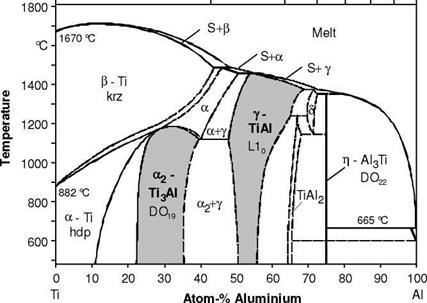An intermetallic compound does not crystallise in the lattice type of one of its two components. It has its own lattice structure typical for the compound. The quantitative ratio of the atoms of both substances corresponds to their amounts in the alloy composition [BUER01]. The Ti-Al system also forms stable intermetallic compounds [ROMM97]. The phase diagram of the two-material system is shown in Fig. 4-14 [KUMP02, MASS90]. Materials based on these compounds are designated as titanium aluminides. The characteristics of so-called y-titanium aluminides are derived from the properties of the intermetallic a2-(Ti3Al), packed with maximum hexagonal density, and the y-(TiAl) phase, from both of which the material is composed. Both of these phases can be found in varying phase fractions and microstructures, such as duplex or fully lamellar structures.
|
Weight-% aluminium 0 10 20 30 40 50 60 70 80 90
Fig. 4-14. Phase diagram Ti-Al [KUMP02, MASS90] |
The duplex structure consists of globular у-grains, a2-particles and lamellar y/a2-grains with approximately equal volumetric portions, Fig. 4-15, right [WANG00]. It is the finest-grained microstructure of TiAl-based alloys and exhibits good space-temperature ductility [KUMP96, ROMM97, YAMA93]. The ductility is dependent on structural homogeneity, but it can also be influenced by further alloying elements or the amount of impurities [HUAN91, HUAN94, KIM89, KIM91, KIM94, ROMM97, YAMA93].
Fully lamellar (FL) structures (Fig. 4-15, left) consist of parallel-arranged lamellae of both the tetragonal TiAl phase and the Ti3Al phase, which is packed with maximum hexagonal density [WANG00]. The width of the lamellae varies according to the heat treatment used and further alloying additives between 0.15 und 3 pm, whereby the width of the a2-lamellae is, as a rule, significantly less than that of the y-lamellae [BERG95, ROMM97]. The boundary surfaces of two grains can in this case form a “hooked” structure by means of a “meshing mechanism”, which has a positive effect on creep strength but a generally negative one on material machinability [WANG99]. These structural types have higher fracture toughness, improves high temperature strength properties and a higher endurance limit than duplex structures.
|
Fig. 4-15. Left: microstructure of a TiAl base alloy with an Fl structure (Ti-45A1- 2Mn-2Nb + 0.8 %TiB2); right: microstructure of a TiAl base alloy with a DP structure (Ti- 46.5Al-3Nb-2.1Cr-0.2W) [KUMP96] |


